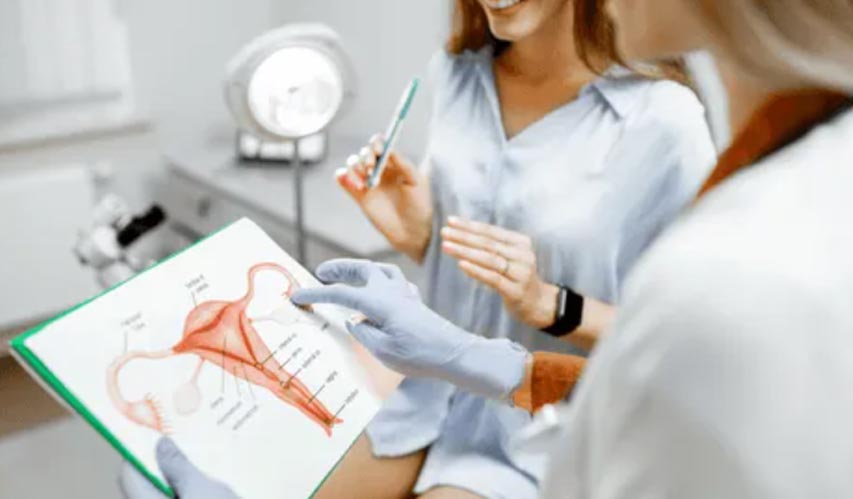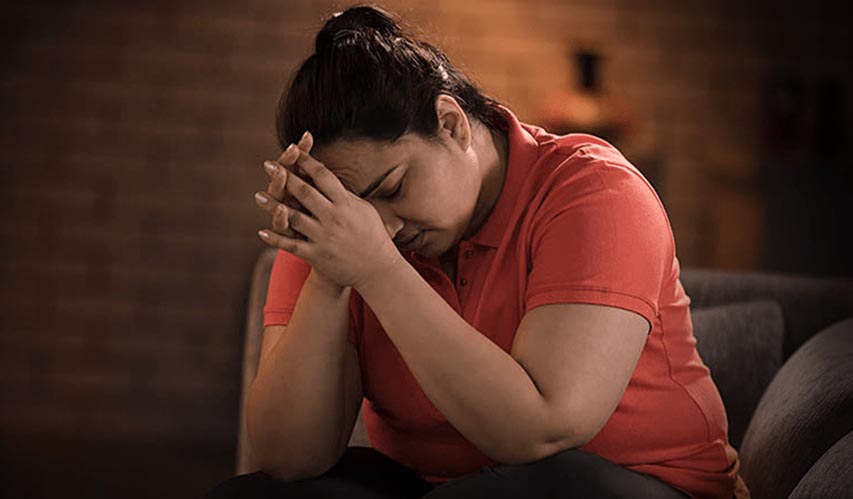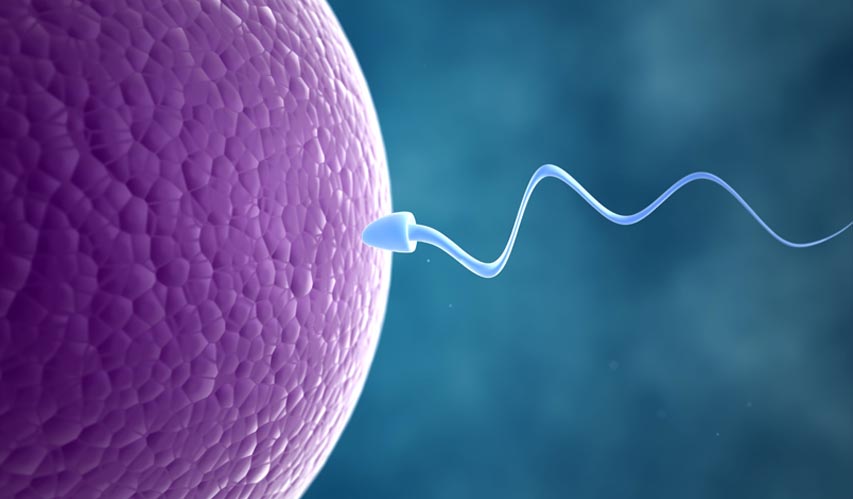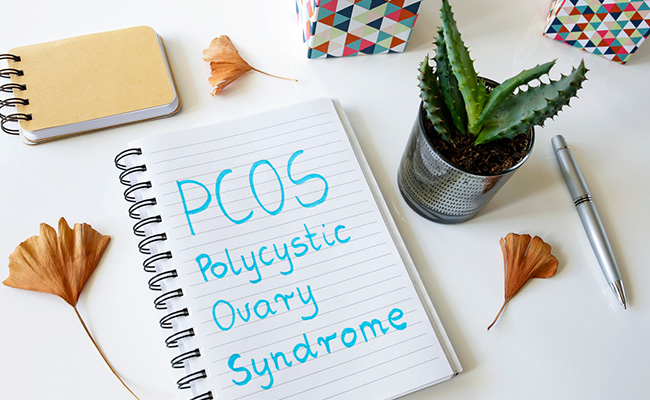
Have you been gaining weight despite your attempts to diet or exercise? Are your acne breakouts reminding you of those teenage years? Losing hair from your scalp, but having unwanted hair growth on your face? Anxious about your irregular periods and wondering why you are unable to get pregnant?
If you are a woman in her reproductive years, then the cause of all this misery is probably PCOS (Polycystic Ovary Syndrome). There is more to PCOS in women than just cysts growing in your ovaries.
What Causes PCOS?
Insulin resistance is the primary cause of PCOS (1).
Insulin is a hormone produced by our pancreas. Insulin’s job is to announce the arrival of energy-giving glucose to the cells in the body. But when the cells are already overflowing with energy, they become reluctant to open their door and take in even more glucose. These cells resist the command given to them by insulin. So, they are said to be insulin resistant.
The body responds to insulin resistance by bombarding the cells with even more insulin, forcing them to open up and accept some glucose. As insulin resistance rises, our pancreas makes even more insulin, thus flooding our system with insulin.
Hormonal Imbalance in PCOS
In women, the extra insulin causes the ovaries to produce more male hormones, namely testosterone. And here is how that happens.
Luteinizing hormone (LH), a hormone made by the pituitary gland, regulates the menstrual cycle in women. It triggers ovulation and releases the egg from the ovary. Even though testosterone is considered a male hormone, women also require it in small amounts. The LH hormone stimulates the ovaries to produce testosterone as needed (2).
Insulin resistance can cause excess secretion of LH (3). As the LH level rises, it causes too much testosterone to get released. And the domino effect continues as the excess testosterone upsets the balance of other reproductive hormones such as estrogen and progesterone. This causes a host of PCOS side effects such as acne, facial hair growth, male pattern baldness, and so on.
Primer on Female Reproductive System
Before starting on the PCOS symptoms, let’s take a quick look at the female reproductive system and the menstrual cycle.

- The uterus is located in your pelvis, between the bladder and rectum. The uterus is also called the womb. The inner lining of the uterus is called the endometrium.
- The ovaries are present outside of the uterus, one on each side. The healthy ovary produces eggs and secretes hormones.
- The follicle-stimulating hormone (FSH), released by the pituitary gland, stimulates the ovaries to produce many follicles on its surface. Each of these follicles contains an immature egg. Of these, only one egg matures while the rest die. This happens around the 10th day of a 28-days menstrual cycle.
- The process of the mature egg getting released during each monthly cycle is known as ovulation (4). This takes place about 2 weeks before menstruation, or around the 14th day of a 28-days menstrual cycle. Ovulation is triggered by the Luteinizing hormone (LH) hormone.
- There is a thin tube-like structure, starting at the ovaries and ending at the uterus. These are called the fallopian tubes.
- The released egg moves through the fallopian tubes towards the uterus and waits there for a sperm to fertilize it. The lifespan of the egg is for less than 24 hours.
- Remember we told you that the inner lining of the uterus is called endometrium? Till the menstrual bleeding starts, the endometrium thickens in preparation for the pregnancy.
If pregnancy does not occur, the uterus sheds its lining along with the egg in it. The blood vessels feeding the endometrium rupture during this process, releasing blood. So menstrual bleeding is made up of the shredded endometrium and its blood. Some of this comes out as blood clots as well.
Now that we have some understanding of insulin resistance, excess production of male hormones, and the functioning of the female reproductive system, let us see how they all play a part in PCOS symptoms.
Common Symptoms of PCOS
One thing to keep in mind is that not everyone suffers from all these symptoms. You may be experiencing only a few of these symptoms. On the other hand, having any of these symptoms is not a confirmation of PCOS as they can be due to other causes as well. If you do have these PCOS symptoms, please seek an expert medical opinion.
1. Cysts on the Ovaries
Ovarian cysts are one of the most common symptoms of PCOS as the term ‘polycystic’ evidently suggests. But not every woman with PCOS has PCOS cysts.
The follicles in which the eggs grow are fluid-filled structures. After the egg gets released during ovulation, the fluid is drained and the follicle shrinks to a much smaller size.
In PCOS, when ovulation gets disrupted, the egg is not released and the fluid in the follicles is not able to drain. This may cause the follicle to swell up and eventually turn into a cyst. Many such cysts can be found in the ovaries of women with PCOS.
2. Suppressed Ovulation
As mentioned earlier, your reproductive hormones tend to be out of whack when you have PCOS. When the excess testosterone causes egg-bearing follicles to turn into cysts in the ovaries, the eggs are unable to mature enough to trigger their release. This suppresses ovulation.
Irregular periods: The frequency and duration of their period get affected when women with PCOS ovulate infrequently or they may not ovulate at all. This means they have irregular periods or their period is absent.
Heavy bleeding: The longer the gap between the periods, the more the uterine lining (endometrium) builds up and the heavier the menstrual bleeding.
3. High Testosterone
Though the primary cause of PCOS is insulin resistance and the high insulin levels in the body, it is the high testosterone levels that grab all the attention in PCOS. When PCOS is suspected, blood tests of PCOS hormones such as testosterone, estrogen, LH, and FSH levels are conducted in the blood. Funnily, the insulin levels in the blood are rarely checked.
Excess testosterone is responsible for many of the PCOS effects that are most evident, such as adult acne, male-pattern baldness, losing hair from where you want it to be (your scalp), and hair growing where you don’t want it to be.
Hair growth (hirsutism): Over seventy percent (70%) of women with PCOS may find unwanted hair growing on their face and in other places such as their chest, belly, and back (5). Even when you shave or wax it off, the hair just grows back coarser than before and you may end up with bumps of ingrowing hair.
Male-pattern baldness: High testosterone levels in males are associated with a receding hairline and bald spots on the crown of the head (6). For women, female pattern hair loss can cause their hair to thin out (7). Their front hairline usually remains unaffected. But in women with PCOS, bald patches or receding frontlines can result from the increase in their testosterone levels.
Adult acne: Acne breakouts are another undesirable PCOS side effect that results from increased testosterone levels. The higher the level of testosterone, the more severe the acne tends to be (8). These blackheads or whiteheads may be found not just on your face, but on your chest, shoulders, and back as well.
4. PCOS and Weight Gain
Most cases of PCOS weight gain are the result of insulin resistance and insulin resistance also makes it easy to add more weight (9). So if you are struggling to lose weight and yet seem to be putting on even more fat, then you may have PCOS.

Abdominal obesity: Even if you are a slim person, you may still have a potbelly. The body fat stored within the belly area is called visceral fat. Belly fat or weight gain on the waistline is a symptom of insulin resistance and PCOS (10). Your waist circumference can be a clear indicator of insulin resistance. In fact, belly fat is considered one of the most prominent PCOS symptoms (11).
5. Darkening of the Skin
If you are examining yourself for signs of PCOS, then look for dark skin patches.
As we explained before, insulin resistance causes excess insulin. The excess insulin develops darker skin shades in the body creases/skin folds, underarms, groin, and under the breast. These thick, dark velvety skin patches are known as acanthosis nigricans (12).
6. Skin Tags in the Armpits or Neck Area
Since skin tags are strongly associated with insulin resistance, it’s no surprise that it is one of the signs of PCOS (13).
Skin tags are generally harmless and painless. They are non-cancerous growths, small flaps of excess skin, which are connected by a small thin stalk. In women with PCOS, skin tags are usually seen on the neck and armpits (14).
Although they start out the same color as your skin, constant friction can make them much darker in color. Trying to cut off skin tags by yourself can lead to bleeding, infection, and scarring. A doctor can help you remove them safely.
7. Headaches
The hormonal changes that occur in PCOS can also trigger headaches and migraines. This is often aggravated by the sleep issues faced by these women. Stress can also be an added factor.
8. Pelvic Pain
Pelvic pain is a less common symptom of PCOS. The polycystic ovaries cause this and can be felt as a dull ache that comes and goes. Somes sharp jolts may also be felt.
PCOS and Infertility

Many women find out about their PCOS when they are unable to get pregnant and finally get a medical check-up. PCOS is a leading cause of infertility in women (15). It can affect a woman’s fertility in many ways.
Women with PCOS can get pregnant, but most PCOS females often have trouble conceiving due to their ovulation problems. The irregular and unpredictable menstrual cycle makes it difficult for women with PCOS to get pregnant.
The hormonal imbalance disrupts the development and release of mature eggs and without a healthy, mature egg, ovulation and pregnancy are not possible. If ovulation does not occur regularly, the ovaries are not able to release as many eggs, which in turn reduces the chances of an egg being fertilized by the sperm.

Even if ovulation does take place, the hormonal imbalance may prevent the egg from getting implanted in the uterus as the lining may not have developed properly. Getting pregnant with PCOS after 30 can be difficult unless you take the necessary steps to manage your PCOS symptoms.
Health Problems that Go Along with PCOS
Whatever causes PCOS can also lead to chronic inflammation and many other health complications such as type 2 diabetes, hypertension, high blood cholesterol, heart disease, and stroke. Women with PCOS should get themselves checked periodically for these health problems.
Diabetes type-2: Insulin resistance and PCOS can lead to prediabetes and eventually type-2 diabetes if not treated.
High blood cholesterol: About 70% of women with PCOS have high levels of triglycerides and decreased levels of HDL (16).
Hypertension: Increased blood pressure is often found in those with PCOS (17). Hypertension is another risk factor for cardiovascular disease.
Metabolic syndrome: Metabolic syndrome is a cluster of conditions that include high blood pressure, high blood sugar, and high LDL cholesterol. The underlying cause of the metabolic syndrome is insulin resistance. So, a woman with a PCOS diagnosis most definitely has metabolic syndrome.
Chronic inflammation: Chronic low-grade inflammation in women with PCOS is associated with insulin resistance and increased cardiovascular disease risk (18, 19).
Heart disease: There is evidently a higher number of risk factors for cardiovascular diseases in women with PCOS than in those who do not have it (20, 21).
Sleep apnea: This is a sleep disorder where your breathing repeatedly stops and starts. A high prevalence of obstructive sleep apnea is seen in women with PCOS (22). If you have a tendency to snore loudly and you feel tired in the daytime despite sleeping a full night, then you probably have sleep apnea. Obese women with PCOS are 5 to 10 times more likely to have sleep apnea than similarly obese women who do not have PCOS (23).
Endometrial cancer: In women with regular menstrual cycles, the uterine lining is shed regularly. With PCOS and irregular menstruation, the uterine lining builds up and over time it gets thick. A thick uterine lining is a risk factor for endometrial cancer (24).
Anxiety and Depression: Hormonal changes by themselves can cause anxiety and depression (25). The hormonal fluctuations can cause mood swings. Combined with weight gain, and PCOS symptoms such as unwanted hair growth and acne, the impact on the person’s well-being can be quite negative.
The inability to get pregnant with PCOS and conceive a child sends many women into serious depression. Symptoms of PCOS can wreak havoc on your confidence and self-esteem (26). All these things can lead to anxiety and depression.
Conclusion

Mainstream medicine assumes that the cause of PCOS is unknown. If the cause is unknown, it implies that treatment is unknowable.
So, if you are wondering whether PCOS can be cured, the first thing to identify is the cause, rather than just treat the symptoms.
The vast majority of PCOS is the result of excess insulin, and excess insulin is usually the result of insulin resistance and insulin resistance is usually the result of excess fat gain. So, losing sufficient weight may be able to diminish PCOS effects or fully reverse PCOS and restore ovulation and fertility.
